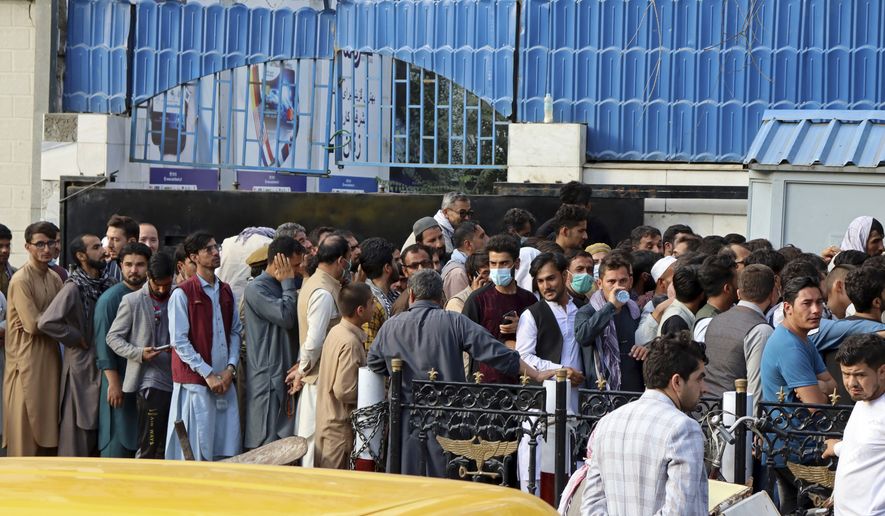A man who had been convicted of rape and deported from the U.S. was allowed to board an Afghan evacuation flight and reach America, law enforcement sources say.
When American citizens were having trouble catching flights out of Kabul, Ghader Heydari made it on an Ethiopian Airlines charter flight for evacuees.
Border officials flagged the 47-year-old on his arrival at Washington Dulles International Airport. They appear to be the first to have spotted his criminal and immigration history and derailed his entry.
Heydari is being held at the Caroline Detention Facility in Bowling Green, Virginia, The Washington Times has learned.
“They are bringing far too many people in far too quickly to be able to effectively vet them,” said Ken Cuccinelli, a deputy secretary at Homeland Security in the Trump administration.
Heydari’s exact path to entry is not clear, though it’s unlikely he holds a Special Immigrant Visa. Those were reserved for Afghans who provided significant support for the U.S. in the war effort.
It’s also not likely he is a refugee, given his immigration history.
That leaves parole, a power the homeland security secretary has to grant admission to the U.S. in exceptional humanitarian cases. Most Afghans evacuated to the U.S. appear to be parolees rather than having official immigration status.
The Times has reached out for comment from the Department of Homeland Security and Customs and Border Protection, the agency that mans the ports of entry, including Dulles.
A senior administration official briefing reporters last week said security checks were supposed to be completed outside the U.S.
“That happens at the transit hubs, and it happens before individuals are allowed into the United States,” the official said. “That’s, in particular, with the biometric and biographic security screenings that our colleagues in the intelligence community and law enforcement and other counterterrorism components of our government are doing.
“So that is where we are doing that work to ensure that however it is — whatever is happening on the ground at HKIA, before individuals are allowed into the United States, they receive that security vetting,” the official said, using the acronym for Hamid Karzai International Airport.
Either that process wasn’t followed in the case of Heydari or his rape conviction and deportation weren’t enough to keep him off the evacuee flight.
Heydari came to the U.S. as a refugee sometime in the previous century and was granted a green card in 2000.
A man whose name and age match Heydari’s pleaded guilty to rape in Ada County, Idaho, in 2010. He served more than five years in a state prison and was released on supervision in December 2015, according to state records.
He was ordered deported by an immigration judge in 2016 and was removed in 2017.
When Heydari arrived in the U.S. on the evacuation flight, officials tried to persuade him to cancel his request to enter, formally known as withdrawal of application for admission, but he appears to have refused.
The U.S. ended its military mission Monday after evacuating more than 116,000 people since Aug. 14. Only a tiny fraction — 6,000 to 7,000 — were Americans. Hundreds of Americans who wanted to leave were stranded as the final flight departed, though U.S. officials said they had plans to help them.
Many of the evacuees were Afghans. Some, like Heydari, have been airlifted to the U.S. Others were taken to third countries for more processing.
Security analysts have warned of the danger involved with the massive airlift of people from Afghanistan to the U.S. and holes in vetting.
The airlift was billed as a chance to get Afghans who assisted the U.S. war effort out of the country as part of a promise for their help. Those Afghans are supposed to be eligible for the Special Immigrant Visa.
But the airlift turned into a free-for-all. Relatively few Afghans brought to the U.S. have been approved for SIVs or cleared as refugees. Most appear to have been entered under Homeland Security Secretary Alejandro Mayorkas’ power of parole, special permission that is supposed to be reserved for exceptional humanitarian cases.
Rep. Thomas P. Tiffany, Wisconsin Republican, toured Fort McCoy in his home state on Friday. Of the 2,000 Afghans being held there, not a single one was an SIV holder, he said.
“I still do not have a clear idea of the vetting process. They say that people are fully vetted, but we ask what does that mean? We take biometric data, those type of things, but I said what do you tie it back to?” Mr. Tiffany told The Washington Times.
Given that the Afghan government has fallen and the Taliban are now in charge, it’s not clear what access the U.S. has to verify records.
“We want to know what people’s history is, and I get the sense they’re just pushing these people through,” Mr. Tiffany said.
A lack of information was the same issue the U.S. faced during the Obama years when the administration vowed to welcome tens of thousands of Syrians escaping their country’s civil war but struggled to vet them with a government the U.S. was trying to topple.
Authorities have spotted some potential security risks among the Afghan evacuees.
More than 100 prospective SIV recipients were flagged as potential matches to names on U.S. intelligence watch lists, Defense One reported.
One man evacuated from Kabul has potential ties to the Islamic State group. That person was evacuated from Afghanistan to another country to undergo vetting. Unlike Heydari, he was not brought onto U.S. soil.
• Stephen Dinan can be reached at sdinan@washingtontimes.com.




Please read our comment policy before commenting.